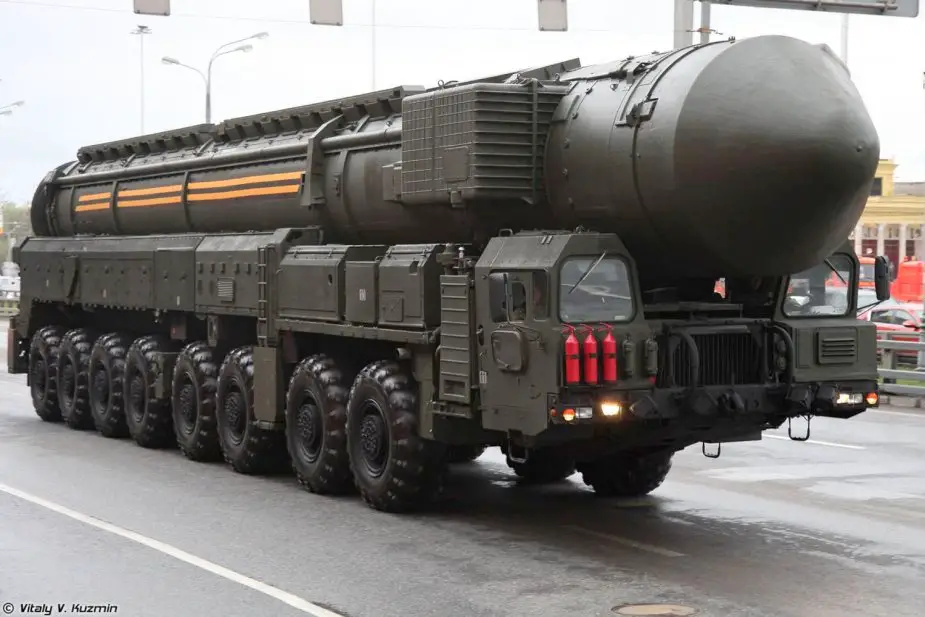Breaking news
Russian first live fire test of Sarmat ICBM to be considered as routine demo.
President Vladimir Putin announced on April 20 that his country successfully test-launched an intercontinental ballistic missile (ICBM) with the potential to carry a large nuclear payload, but the Pentagon said it was not a significant threat to the United States, just routine. Putin was shown on TV being told by the military that the long-awaited RS-28 Sarmat missile had been test-launched for the first time from Plesetsk in northwest Russia and hit targets in the Kamchatka peninsula, nearly 6,000 km (3,700 miles) away.
Follow Army Recognition on Google News at this link

RS-28 Sarmat ICBM (Picture source: Vitaly Kuzmin)
“This truly unique weapon will strengthen the combat potential of our armed forces, reliably ensure Russia’s security in the face of external threats, and will provide food for thought to those who in the heat of frenzied aggressive rhetoric try to threaten our country,” Putin said on TV.
The RS-28 Sarmat, which NATO has dubbed “Satan 2,” is considered Russia’s most powerful ICBM: a super-heavy, thermonuclear-armed intercontinental-range ballistic missile. It was introduced during a 2018 address to the nation as the “next generation” of weaponry that could breach “any missile defense” system.
Pentagon spokesman John Kirby told reporters on April 20 that the United States did not consider the weapon a threat to Washington or its allies. However, as reported by The Washington Post, John Erath, senior policy director for the Center for Arms Control and Non-Proliferation, said: “We should be very concerned about this practice of making threats as an instrument of Russian policy [that] is gaining currency”. After Russia’s February invasion of Ukraine, the United States postponed and subsequently canceled a planned test of the Minuteman III intercontinental ballistic missile, a decision made to ensure that Russia would not misconstrue such a display of firepower — or use it as justification to escalate the hostilities in Ukraine.
RS-28 Sarmat ICBM
The RS-28 Sarmat (NATO reporting name: SS-X-29 or SS-X-30), sometimes colloquially known in the West as the "Satan II", is a liquid-fueled, MIRV-equipped super-heavy intercontinental ballistic missile (ICBM) under development by the Makeyev Rocket Design Bureau since 2009. It is intended to replace the R-36M ICBM (SS-18 'Satan') in Russia's arsenal. The Sarmat is one of the six new Russian strategic weapons unveiled by Russian president Vladimir Putin on 1 March 2018. The RS-28 Sarmat made its first test flight on 20 April 2022.
The 200-ton ICBM is capable of carrying about 10 tonnes of payload for either up to 10 heavy or 15 light MIRV warheads, an unspecified number of Avangard hypersonic glide vehicles (HGVs) or a combination of warheads and several countermeasures against anti-ballistic missile systems. The Russian Ministry of Defense said that the missile is Russia's response to the U.S. Prompt Global Strike system.
Sarmat has a short boost phase, which shortens the interval when it can be tracked by satellites with infrared sensors, such as the U.S. Space-Based Infrared System, making it more difficult to intercept. It is speculated that the Sarmat could fly a trajectory over the South Pole, completely immune to any current missile defense system and that it has the Fractional Orbital Bombardment (FOBS) capability.
According to various sources, RS-28's launch sites are to be equipped with the "Mozyr" active protection system, designed to negate potential adversary's first strike advantage by discharging a cloud of metal arrows or balls kinetically destroying incoming bombs, cruise missiles and ICBM warheads at altitudes of up to 6 km.

ICBM transport vehicle demonstrated at Armya-2018 (Picture source: Army Recognition)



















